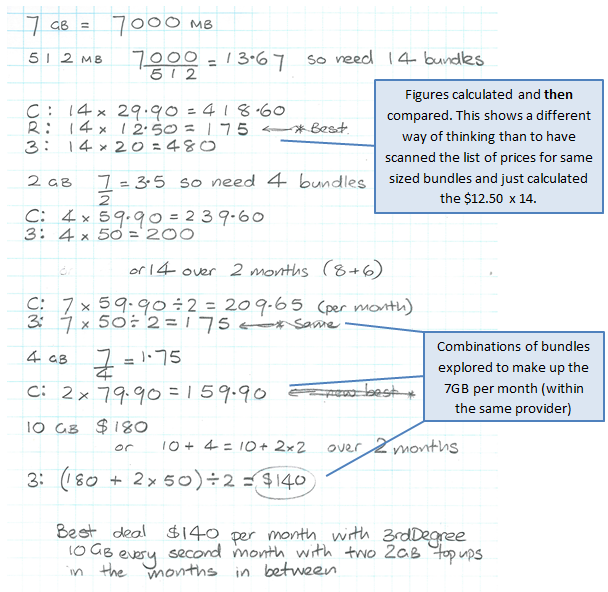The purpose of this activity is to engage students in using proportional reasoning to find a solution to a problem in context.
This activity assumes the students have experience in the following areas:
- Converting between fractions and decimals.
- Expressing money amounts using decimals.
- Calculating with proportions, ratios, and rates.
The problem is sufficiently open ended to allow the students freedom of choice in their approach. It may be scaffolded with guidance that leads to a solution, and/or the students might be given the opportunity to solve the problem independently.
The example responses at the end of the resource give an indication of the kind of response to expect from students who approach the problem in particular ways.
Task: Sally uses a lot of data on her mobile. She is currently with Cellcom and in a long term contract that provides the phone and a monthly 60 minute calls, unlimited texts and 1GB data bundle. Sally actually uses an average of 8GB per month. The extra 7GB of data that she uses is billed at a very high rate ($5 per 50MB). When she pays her monthly mobile bill, she has the option of purchasing additional data bundles at a reduced rate.
Use the table below, showing the specials on data bundles that are available on monthly top ups, for the three mobile providers, Redfone, Cellcom and 3rdDegree, to work out which provider and which bundle(s) would give her the best deal for an additional 7GB per month.
| Provider | Cellcom | Redfone | 3rdDegree |
| 512 MB | $29.90 | $12.50 | $20 |
| 2 GB | $59.90 | $50 | |
| 4 GB | $79.90 | ||
| 10 GB | $180 |
In all cases, any unused data at the end of the month is carried over for a maximum 30 days.
Note, we can assume that the calls, texts and data bundles for Redfone and 3rd Degree are similar. If Sally breaks her contract with Cellcom, she will need to purchase a new phone.
The following prompts illustrate how this activity can be structured around the phases of the Mathematics Investigation Cycle.
Make sense
Introduce the problem. Allow students time to read it and discuss in pairs or small groups.
- Do I understand all the information in the problem, or should I ask for help?
- What are the important words and symbols? (Students will need to know the meaning of the units, megabyte (MB) and gigabyte (GB) and how the units relate.)
- Have I got all the information I need? Do I need to makes some assumptions?
- Does this look/sound like a problem I have worked on before? (Students may have experience with finding best deals.)
- What will an answer to this problem look like? (The answer must choose a best deal and justify the decision using calculations.)
Plan approach
Discuss ideas about how to solve the problem. Emphasise that, in the planning phase, you want students to say how they would solve the problem, not to actually solve it.
- What are the maths skills I need to work this out? (Working with rates is important, e.g., 4 x 512 MB = 2048 MB = 1.048 GB)
- Can I predict the best deal? How would I do that?
- How could I organise the information in this problem? (A table is a good way to organise the calculations.)
- What tools (digital or physical) could help my investigation?
Take action
Allow students time to work through their strategy and find a solution to the problem.
- Have I shown my workings in a step-by-step way?
- Does my answer seem correct? How might I check that I found the best deal?
- How could I make sure that I haven’t missed anything?
- What is the same and what is different about all the companies? What differences are important when finding the best deal?
- How do my results look different to others? Why could this be?
- Is there another possible answer or way to find the best deal?
Convince yourself and others
Allow students time to check their answers and then either have them pair share with other groups or ask for volunteers to share their solution with the class.
- What is the best deal? What should Sally do?
- Can I show and explain how I worked out my solution.
- What connections can I see to other situations, why would this be? How would this problem help me to work out other best deals?
- Is there some mathematics that I would like to be able to do that I can't do, at the moment?
- What have I noticed that seems to work all the time? Would the best deal be different if Sally used more, or less, data?
Examples of work
Work sample 1
The student calculates the different costs of data bundles for the required usage, to recommend a purchase plan.
Click on the image to enlarge it. Click again to close.
Work sample 2
The student considers the context alongside calculation of the costs of data bundles, to find the optimal solution.

